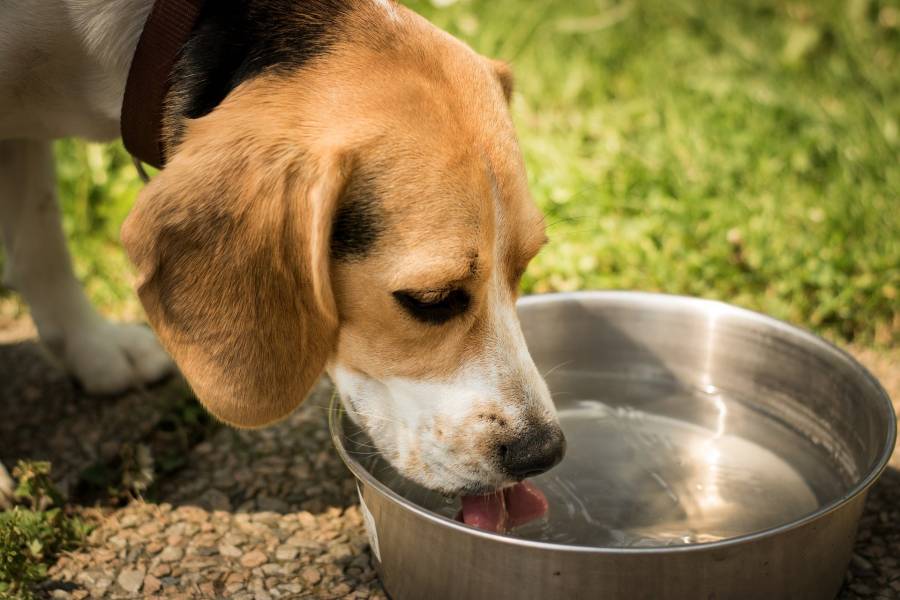Quick Navigation
Seeing your dog not eating but drinking water and vomiting may be concerning, especially if this behavior continues for a few days.
But before you lose your composure and expect the worst, breathe.
Your puppy’s condition may not be as critical as you think.

The following information should help you identify why your dog is acting this way.
And if other symptoms accompany this behavior, you’ll learn what to do to help it recover.
5 Reasons Your Dog Isn’t Eating But Is Only Drinking Water And Vomiting
If your dog stopped eating and only drank water and vomited, it’s probably not feeling well.
This behavior is related to many issues, such as the five below.
If you think your dog has one of these, follow the ‘Next Step’ recommended.
1. Illness
Your dog may not be eating but drinking water and vomiting because it’s ill. You’ll notice it’s also growing lethargic because it’s feeling weak.
To be more specific, three issues may be causing this behavior, and those are:
- Gastrointestinal Problems – If any of the above symptoms come with signs of pain and discomfort, your dog may have a gastrointestinal issue. Your dog won’t eat and will drink excessively in hopes of getting better. Unfortunately, the vomiting will dehydrate, making it drink even more water.
- Infection – Dogs that tend to be outdoors often may pick up an infection after eating or chewing on something. Vomiting may also indicate food poisoning due to ingesting the wrong types of foods.
- Digestive Blockage – Vomiting and reduced appetite, and increased water intake can result from a digestive blockage. Again, this is caused by something your dog ingests at home or outdoors.
Next Step: If you suspect your dog has any of these, take it to the vet immediately. These are serious concerns that require the attention of a professional.
Additionally, dogs who lose their appetite are said to have anorexia or inappetence.
In contrast to anorexia in humans, canine anorexia is a different condition.
There are different levels of canine anorexia.
Partial anorexia manifests when your dog consumes only a portion of the recommended daily intake of food.
You’re dealing with complete dog anorexia if your dog won’t eat anything.
When a dog craves food but is unable to do so due to another issue, it is said that the dog has pseudo-anorexia.
Furthermore, your dog may not be eating if you see any broken, loose, or unhealthy teeth, or any gum inflammation.
Look for lumps, injuries, changes in your pet’s fur or skin, parasites, and changes when inspecting their body.
2. Stress
Stress in dogs may be a result of several situations, such as:
- Being left alone for an extended time
- Moving to another home or city
- Experiencing loss, such as the death of a family member or other pet companion
Because of these, your dog may show signs like growling/whining, pacing, whale eyes, and lip-licking.
Unfortunately, ignoring these will result in severe symptoms like your dog not eating, drinking excessively, and vomiting.
Next Step: You’ll need to consult with your vet since lack of appetite, excessive drinking, and vomiting are significant symptoms.
Once these begin receding, you need to take steps to keep your dog calm. Here are some essential measures.
- Spend more time with your dog, especially if you just moved or lost a loved one or pet. Your dog needs this since you’re the only consistent part of its life.
- Plan more exercise time for your dog. You can get an indoor agility kit or fetch toy if you can’t take your pup out for walks.
- Get puzzle toys to provide your dog with ample mental stimulation. It will make it calm and distract it from the source of stress.
- Create a safe space for your pup. It can be a calming dog bed or crate. Add a DAP diffuser or your dog’s fave blanket to boost this place’s serenity.
3. Vaccine Side Effects
If your dog isn’t eating but drinks more and vomits after vaccinations, it probably develops a severe side effect.
It is usually accompanied by difficulty in breathing, swelling around the face, and constant itching.
Next Step: Keep an eye on your dog for the next two days after vaccination. If your dog still doesn’t eat, only drinks water, and vomits, take it to the vet.
4. Switching Food
Your puppy may have switched food because of age, newly discovered allergies, obesity, or medical issues.
If your pooch is a picky eater, it may not like the new flavor or brand you’re serving it.
Alternatively, its symptoms could result from a reaction to the new food.

Next Step: If you have a picky eater on your hands, you’ll need to coax them into eating their food.
For instance, you can mix the new food with the one they like.
Just remember to constantly provide your dog with love and praise to be at ease.
But if your dog’s condition is because the food isn’t suitable, you need to consult with a vet.
They may suggest alternatives that won’t make your dog stop eating, drink excessively, and vomit.
5. Change In Routine
Dogs are creatures of habit and can be easily affected by routine changes.
For instance, changing their feeding or walking schedules can agitate them.
And once they become nervous, dogs stop eating, only drink more water, and vomit.
Next Step: In general, dogs cope better with minor changes. If you’re expecting more change ahead, plan it in a way that makes the transition easier.
You can also consider refreshing your dog’s creating training.
Don’t worry; most dogs see the crate as a safe space where they can sleep and relax.
But most importantly, avoid making a fuss when it comes to new changes.
For example, don’t give your dog lots of attention while leaving the house at different times.
It would only alert them to the fact this is a new change.
What If Your Dog Doesn’t Eat, Only Drinks, Vomits, And Exhibits Concerning Signs?
Check to see if your dog is acting normally or if the daily routine has changed in any other ways.
Take note of the dog’s stool and urine as well. You can allow your pet to miss one or two meals if everything is fine.
You probably have an idea why your dog may not be eating instead of drinking water and vomiting.
However, things may be different if these behaviors are accompanied by other signs such as shaking, diarrhea, and foaming.
Below are the measures and steps you should take if your dog exhibits these signs.
Your Dog Isn’t Eating But Drinks Water, Vomits, And Shakes
If a dog isn’t eating but is drinking water, vomiting, and shaking, it may be suffering from an upset stomach.
If, however, it doesn’t recover in a few hours, your puppy may be suffering from one of the following.
- Medical Issues – Canine distemper, liver disease, neurological issues, and parasites are reasons your dog’s shaking despite not eating and drinking excessively.
- Stress and Anxiety – Shaking can be attributed to stress, which you already know can cause the other two symptoms. Other symptoms that can help you confirm this include pacing, whining, drooling, changes in ears and eyes, and shedding.
Suppose you suspect any medical issue, head to the vet ASAP, especially if these symptoms are fever-related.
On the other hand, if your dog is only stressed, refer to the tips above for calming your dog.
The Dog Isn’t Eating But Drinks Water, Vomits And Has Diarrhea
The cause of dogs not eating, drinking more water, vomiting, and suffering from diarrhea is usually an upset stomach.
You can manage your dog’s diarrhea early at home if it isn’t severe or too frequent.
For a grown dog, fasting for a short period can help.
If you have a puppy, provide it with a bland diet such as boiled chicken and rice.
You can also call your vet to recommend any medications to help firm up the stool.
If diarrhea persists after 12 hours, head to the vet immediately so they can give your dog fluids intravenously.
The vet may also administer treatments for underlying causes such as antibiotics.
Your Dog Doesn’t Eat, Only Drinks Water, Vomits, And Starts Foaming
There are several reasons dogs stop eating, drink more water, vomit, and begin foaming.
It would be best if you took action according to the severity of your puppy’s condition.
- Nausea – Your pup may feel sick or have a gastrointestinal issue that’s causing it hypersalivation. In this case, a trip to the vet is a must.
- Stress – Dogs foam at the mouth when stressed and anxious. If this happens during situations such as vet visits or when you leave, make your pup feel at ease. And you know exactly how to do so.
- Dental Disease – Dental inflammation can impact your dog’s appetite and drinking habits and result in hypersalivation. In this scenario, smell your dog’s breath. If the odor is unpleasant, visit the vet to check its teeth and plan a detailed cleaning. Foul breath aside, be on the lookout for panting, blood in the water bowl, and decreased activity.
- Poisoning – If your dog has seizures and a foaming mouth, it may have been poisoned. Don’t wait any longer and rush to the pet ER.
Your Pup Will Be Fine, And Here’s How We Know
The fact that you read this whole guide shows how much you love and care for your pup.
It is the commitment it needs to be always safe from harm.
It also ensures your dog will get proper nutrition, exercise, and routine vet checks to stay healthy.
However, keep in mind that your dog can’t verbally tell you what’s wrong.
So, make sure to keep an eye on any early signs of physical distress.
That way, you can have many years of happiness with your four-legged friend.

Zoey is a long-time pet owner and animal rights advocate, a vital part of Purrfect n’ Pawesome. She shares her unique experiences and learnings with her readers to enhance their understanding of pet behavior and nutrition. Along with being an active pet writer, she volunteers at multiple animal shelters, rescue centres with some bespokenly awesome pets.
Zoey has a lot to share when raising the pets and spending life being their true friends. She has a quite pampered Persian cat and a Ragdoll, whom she loves the most. Readout her blogs to know more about being a responsible parent to your beloved pets.
“I love to be around cats and dogs; that’s my passion and my trick to get away from all the negativity and soaking in unconditional love and affection. Being attached to this platform gives me the reason to be vocal about pet love, care, and nurturing. Although I am not an expert or veterinarian by any means, I have a lot of experience and learnings to share with my fellow readers.”
